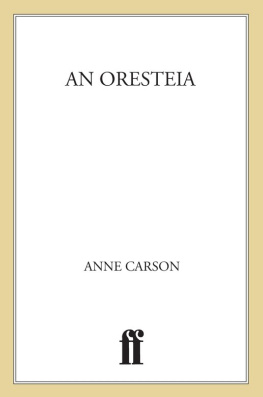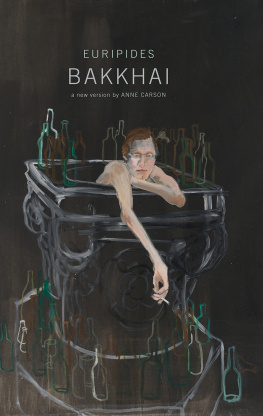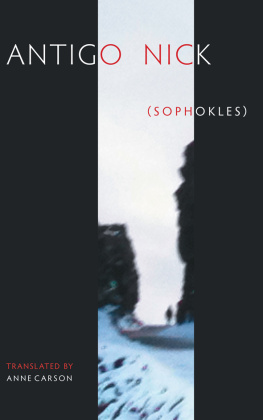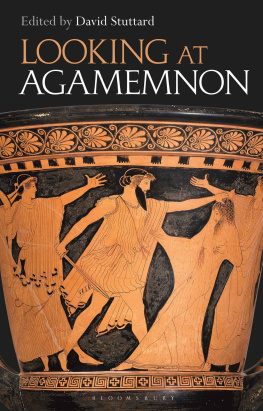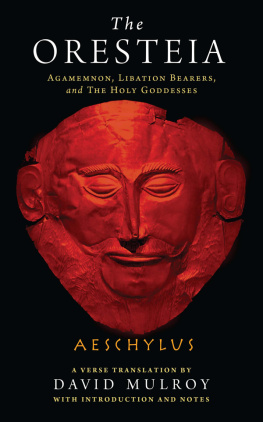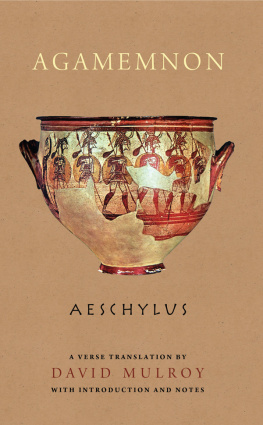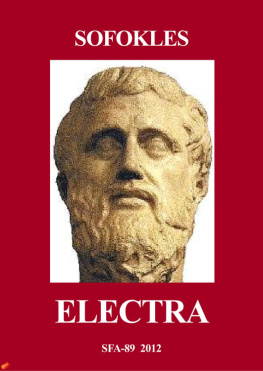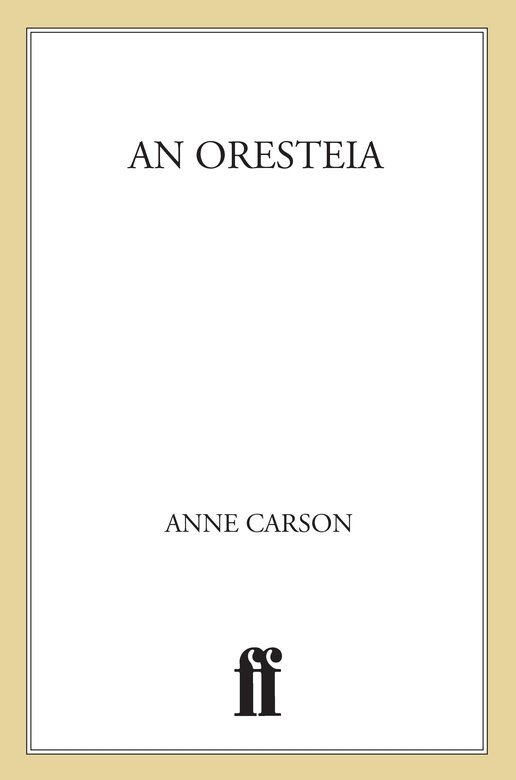Its like watching a forest fire. Big, violent, changing every minute and the sound not like anything else.
Every character in Agamemnon sets fire to language in a different way. Klytaimestra is a master of technologies, starting with the thousand-mile relay of beacons that brings news of the fall of Troy all the way from Asia to her in the first scene. She reenacts the relay in language that is so brilliant and so aggressive, she is like a conqueror naming parts of the world she now owns. She goes on to own everyone in the playthe chorus by argument and threat, Agamemnon by flattery and puns, Aigisthos by sexy cozeningwith one exception. Kassandra she cannot conquer. Kassandras defense, which is perfect, is silence. When Klytaimestra demands to know whether this foreign girl speaks Greek, Kassandra does not answerfor 270 lines (in the original text). Klytaimestra exits.
There is no reason why Kassandra should speak Greek. She is a Trojan princess who has never been away from home before. In fact, she will turn out to command all registers of this alien tongueanalytical, metaphoric, historical, prophetic, punning, riddling, plain as glass. But Apollo has cursed Kassandra. Her mind is foreign in a much deeper way. Although she sees everythingpast, present and future, and sees it truly, no one ever believes what she says. Kassandra is a self-consuming truth. Aiskhylos sets her in the middle of his play as a difference you cannot grasp, a glass that does not give back the image placed before it.
As a translator, I have spent years trying to grasp Kassandra in words. Long before I had any interest in the rest of Agamemnon , I found myself working and reworking the single scene in which she appears with her language that breaks open. I got some fine sentences out of it and thought to publish them, but this seemed vain. I dreamed of her weirdly mixed with the winters of my childhood and imagined a play where someone like Bjrk would sing wild translingual songs while sailing down a snowy river of ancient Asia Minor. But other people have tried such things and anyway the play already exists. It is Agamemnon .
Eventually I accepted that what is ungraspable about Kassandra has to stay that way. Aiskhylos has distilled into her in extreme form his own method of work, his own way of using his mind, his way of using the theater as a mind. The effect is well (if inadvertently) described by the painter Francis Bacon, who (talking about his own method of painting) says:
It seems to come straight out of what we choose to call the unconscious with the foam of the unconscious locked around it
Francis Bacon makes his paintings, as Kassandra makes her prophecies, by removing a boundary in himself. He wants to access something more raw and real than the images articulated by his conscious mind. Interestingly, he finds reading Aiskhylos especially conducive to this end:
Reading translations of Aeschylus opens up the valves of sensation for me.
Perhaps this is because Aiskhylos knows how to get these valves open too. Not just in the Kassandra scene but everywhere in Agamemnon there is a leakage of the metaphorical into the literal and the literal into the metaphorical. Images echo, overlap and interlock. Words are coined by pressing old words together into new compoundsdayvisible (54), dreamvisible (308), manminded (9), thricegorged (1116), godaccomplished (1127). Metaphors come, go and reappear as fact; for example, the figurative dragnet of allenveloping doom that the Greeks threw over Troy (267) materializes as the very real dragnetevil wealth of cloth in which Klytaimestra snares Agamemnon to kill him (113839). Real objects are so packed with meanings both literal and metaphoric that they explode into symbol, like the red carpet or cloth over which Agamemnon walks as he enters his house (60849).
Francis Bacon says that his own images work first upon sensation then slowly leak back into the fact, He means a violence deeper than subject matter:
When talking about the violence of paint, its nothing to do with the violence of war. Its to do with an attempt to remake the violence of reality itself the violence of suggestions within the image which can only be conveyed through paint We nearly always live through screensa screened existence. And I sometimes think, when people say my work looks violent, that I have been able to clear away one or two of the veils or screens.
This violence is intrinsic to Aiskhylos style. He uses language the way Bacon uses paint, especially in the Kassandra scene where he stages the working of her prophetic mindthe veils, the screens, the violence, the clearing away. She is a microcosm of his method.
Francis Bacon thinks of himself as a realist painter, although he admits this requires him to reinvent realism. Aiskhylos is a realist too. They both have an instinct to trap the living fact alive in all its messy, sensational, symbolic overabundance. Lets return to the red carpet that Aiskhylos unrolls as if in slow motion in the famous carpet scene (60849) that carries Agamemnon into his house and his death. This amazing red object can be interpreted as blood, wealth, guilt, vengeance, impiety, female wile, male hybris , sexual seepage, bad taste, inexhaustible anger and an action invented by Klytaimestra to break Agamemnons will. As a woven thing, it reminds us that women are the ones who weave and that weaving is an analogy for deceptiveness. Klytaimestra will use cloth again when she snares Agamemnon to kill him. As a red or purple-red object, the cloth is bloodlike but also vastly expensive and ruined by trampling. Agamemnon fears that this action will look insolent or impious or bothhe feels all eyes upon him. As a cause of dispute between husband and wife, the red cloth unfolds her power to master him in argument and outwit him in battle. For this is a battle, and when he enters the house, he has lost it. Notice he enters in silence while she comes behind. Then she pauses and turns at the doorway to deliver oneof the most stunning speeches of the play (There is the sea and who shall drain it dry? 650ff.). It is a truism of ancient stagecraft that the one who controls the doorway controls the tragedy, according to Oliver Taplin. In Agamemnon this is unmistakably Klytaimestra. The carpet scene is like a big red arrow Aiskhylos has painted on the play to underscore the fact.
Violence in Agamemnon emanates spectacularly from one particular word: justice. Notice how often this word recurs and how many different angles it has. Almost everyone in the play claims to know what justice is and to have it on their sideZeus, Klytaimestra, Agamemnon, Aigisthos and (according to Kassandra) Apollo. The many meanings of the word justice have shaped the history of the house of Atreus into a gigantic double bind. No one can stop the vicious cycle of vengeance that carries on from crime to crime in its name. The bloodyfaced Furies are its embodiment. I dont think Aiskhylos wants to clarify the concept of justice in any final way, although lots of readers have seen this as the intention of his Oresteia overall. So far as Agamemnon goes, no definition is offered. The play shows that the word makes different sense to different people and how blinding or destructive it can be to believe your justice is the true one. This is not a problem with which we are unfamiliar nowadays. As Kassandra says, I know that smell (886, 983).

